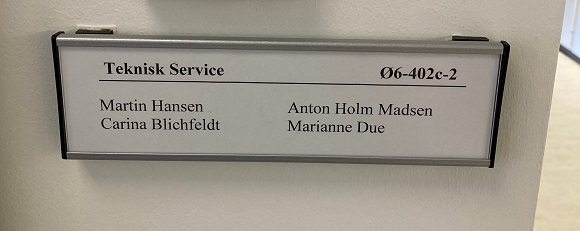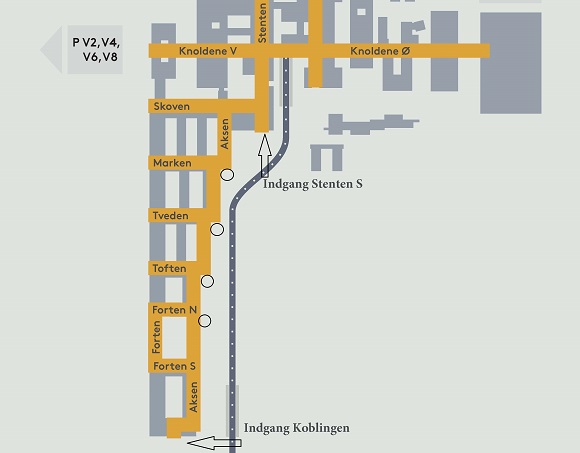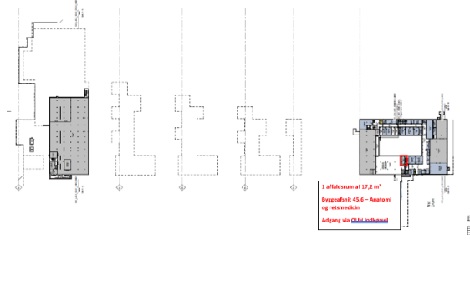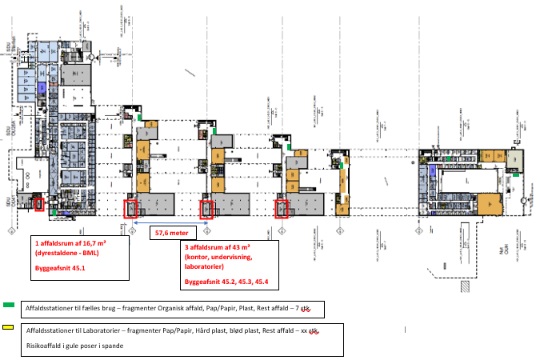THE BUILDING:
The new HEALTH building is located between the existing SDU and the new OUH on Campus Odense.
The building will physically connect the university and the new university hospital. This means that there will be direct access to the new faculty building from both the existing SDU and the new OUH once it is completed.
Through the new HEALTH building, it will eventually be possible to walk 1.3 km from the main entrance of SDU in the north to the main entrance of the new OUH in the south under one roof.

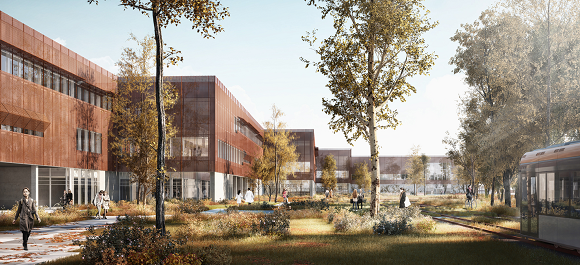
The new HEALTH building continues the architecture that characterizes SDU Campus Odense.
The winged structure with courtyards is reinforced, while the light concrete, the reddish-brown steel, and the glass elements are used in a natural extension of the existing campus architecture.
The new HEALTH building has three floors, which are generally located one floor above the ground with a partial ground floor.
This allows for passage under the building in parts of its stretch, which generally runs in three north-south lanes from SDU in the north to the new OUH in the south.

The new HEALTH building will physically connect the University of Southern Denmark and the new university hospital, Nyt OUH, on Campus Odense.
Once the construction is completed, it will be possible to walk 1.3 kilometers from the main entrance of SDU in the north to the main entrance of new OUH in the south under one roof.
The total construction will cover over 500,000 square meters, with the new HEALTH building accounting for 50,000 square meters of this.
The new HEALTH building will become a workplace for thousands of employees and students at the Faculty of Health Sciences.
The building will house laboratories, offices, meeting rooms, lecture halls, auditoriums, and study areas in addition to animal facilities and facilities for anatomy and forensic medicine.
The following institutes and departments will be located in the building:
- Department of Molecular Medicine
- Department of Public Health
- Department of Forensic Medicine
- Department of Psychology
- Department of Clinical Research (secretariat)
- Department of Regional Health Research (secretariat)
- Faculty Secretariat
- Department of Anatomy
- Biomedical Laboratory
The building will also allocate space for research groups from OUH and other leases.
The construction of the new HEALTH building is ongoing until the beginning of 2023, when SDU will take over the building by the end of April.
Subsequently, in the following months, SDU will carry out technical preparation of the various sections of the building.
From August 1, 2023, SDU will initiate the move into the new HEALTH building.
THE MOVE:
The activities of the Faculty of Health Sciences in Winsløwparken and parts of Campus Odense are to be moved to the new HEALTH building.
The move involves the relocation of people and activities, equipment, apparatus, and furniture and applies to the following institutes, departments, and areas:
- Department of Molecular Medicine
- Department of Public Health
- Department of Forensic Medicine
- Department of Psychology
- Department of Clinical Research (secretariat)
- Department of Regional Health Research (secretariat)
- Faculty Secretariat
- Department of Anatomy
- Biomedical Laboratory
The construction of the new HEALTH building is ongoing until the beginning of 2023, when SDU will take over the building by the end of April.
Subsequently, in the following months, SDU will carry out technical preparation of the various sections of the building.
From August 2023, SDU will initiate the move into the new HEALTH building.
The units and employees who are moving are responsible for:
- Packing their own belongings in moving boxes.
- Preparing their own furniture and IT equipment for the move.
- Labeling moving boxes, furniture, and equipment with moving labels.
Contact persons in the various units will inform individual employees about when they should start packing.
The timetable for each unit will be agreed upon between the contact persons, Technical Service, and Møbeltransport DK.
Packing and preparation of special equipment:
Regarding IT equipment in the laboratories, the method for packing and moving is agreed upon with LAB IT.
For other laboratory equipment, refer to the agreements made at the moving meetings between Technical Service, Møbeltransport Danmark, and the units' contact persons.- See a list of the units' contact persons here. (The list is in Danish)
- More information about packing can be found in the guide here. (The guide is in Danish)
Flyttefirmaet Møbeltransport Danmark is responsible for the move to the new faculty building.
They have previously been responsible for moving the Faculty of Engineering and also handle the smaller internal moves that occur at SDU.
However, if there are special moves, other actors may need to be involved besides Møbeltransport Danmark.
How the equipment should be moved and by whom will be stated in the moving plans, which will be prepared by each unit in collaboration with Technical Services and Møbeltransport Danmark.
You will be provided with a key to the new HEALTH building by the key administrator in your department.
Each unit will collaborate with Technial Services and Møbeltransport DK to develop a detailed moving plan.
During this planning, among many other things, decisions will be made on how the equipment will be moved and by whom.
If there are special moves involved, other actors may need to be involved in addition to Møbeltransport DK.
The ambition is to make it as seamless as possible to start using the new building and to keep core activities running while we move.
Therefore, we strive to make the moving period as short as possible.
Technical Service, together with the individual units, will focus on this in the planning process, so that operational and research activities can be maintained as much as possible.
However, this does not change the fact that the move will to some extent cause disturbance - but we will do what we can to minimize it.
As a starting point, the Department of Molecular Medicine (IMM) will share building 41 with the Department of Biochemistry and Molecular Biology (BMB).
This will continue until BMB can move into the renovated area that the Department of Anatomy will vacate when they move to premises in the new HEALTH building.
IMM's move into building 41 will therefore take place in two stages:
- Move into limited space in the building.
- Occupation of the entire building once BMB has moved and the premises have been renovated.
Moving Plan
The overall timeline for the move specifies the timeframe in which various units from IMM are to move to Building 41.
Since the renovation of Building 41 has not yet been planned in detail, this may affect the timeline.
Further details will be provided at planning meetings with the relevant units, where Technical Service and Møbeltransport DK will develop a detailed moving plan for and in collaboration with each affected unit.
Contact persons:
All units have a contact person(s) who coordinates the local moves.
If you have any questions about the move, the recommendation is to start with them.
Partly because there are likely answers to be found with them, but also so they can gather and send a collective inquiry to Technical Service and stay in the loop with information.
See the list of the units' contact persons here. (The list is in Danish)
That being said, Technical Service naturally answers all inquiries, including those from people other than the contact persons.
Technical Service:
8866@sdu.dk is a shared mailbox for handling inquiries related to Technical Service's tasks in connection with the move to the New SUND.
These inquiries may come from employees at the faculty, members of the project organization, colleagues in Technical Service, or colleagues in the Common Area.
The mailbox should be used to handle inquiries related to cleaning, packing of furniture and equipment, the actual moving process, moving into the new building, and the layout of common meeting rooms, classrooms, and common areas where Technical Service is responsible for planning, execution, and/or assistance.
Since Technical Service has the overall project management of the move to the new HEALTH building, the mailbox can also be used to handle inquiries regarding activities that Technical Service is not directly performing, but are handled by other participants in the project, either in the Common Area or at the faculty.
Technical Service will then ensure that inquiries are forwarded to those responsible for the task related to the inquiry. This may include inquiries regarding rental/sublease agreements, tenders and purchases, IT, and space management.
CANTEEN AND KITCHENS:
In the new HEALTH building, there is access to kitchenettes for staff on the ground floor as well as on the first and second floors.
On the three floors you will find the kitchenettes in connection with office and laboratory areas down through the entire building.
- The ground floor contains 3 kitchenettes
- The first floor contains 10 kitchenettes
- The 2nd floor contains 16 kitchenettes
As a rule, there will not be local lunchrooms reserved for a special staff group.
Lunch, on the other hand, can be taken in the large dining area in the building's western walkway over Killerup Rende or in the existing canteens at SDU.
See location of kitchenettes in the new HEALTH building here.
In addition to the kitchen elements themselves, all 29 kitchenettes in the new HEALTH building are equipped with:
- New fridge (Gorenje)
- New microwave (Samsung 28 liters)
- New dishwasher (Grundig)
- New electric kettle (Point)
In addition, it will also be possible to install a coffee machine in all kitchenettes.
The coffee machines are moved from WP and placed strategically. If it turns out that there are not enough machines, the faculty will order more.
It is initially Technical Service that pays for appliances.
Example of the arrangement of a kitchenette:
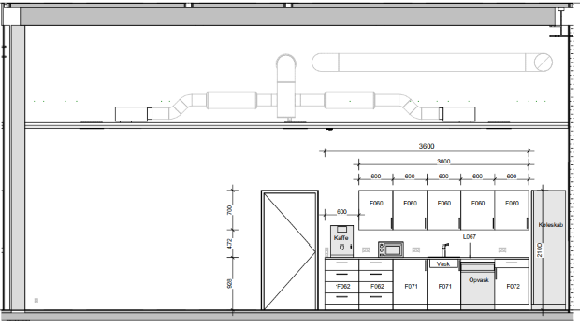
In the new HEALTH building's western walkway over Killerup Rende, there will be a large dining area with a view of nature on the first floor.
Here you can also buy a sandwich and a cup of coffee in a canteen sale. However, there will not be a dedicated canteen in the HEALTH building. Here you must use the existing canteens at SDU.
As a rule, there will also be no local lunchrooms reserved for a special staff group.
Location of the dining area in the new HEALTH building:
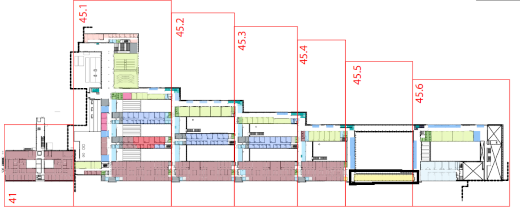
OFFICE SPACES:
The new HEALTH building runs in three tracks from SDU in the north to New OUH in the south.
The three tracks are distributed over three floors, where the offices are primarily located on the 1st and 2nd floor in the middle track.
In addition, offices will be set up for laboratory technicians and researchers immediately opposite the laboratories on the first and second floors in the laboratory track to the west.
Furthermore, there will be offices in the arrival area at the main entrance to the new faculty building.
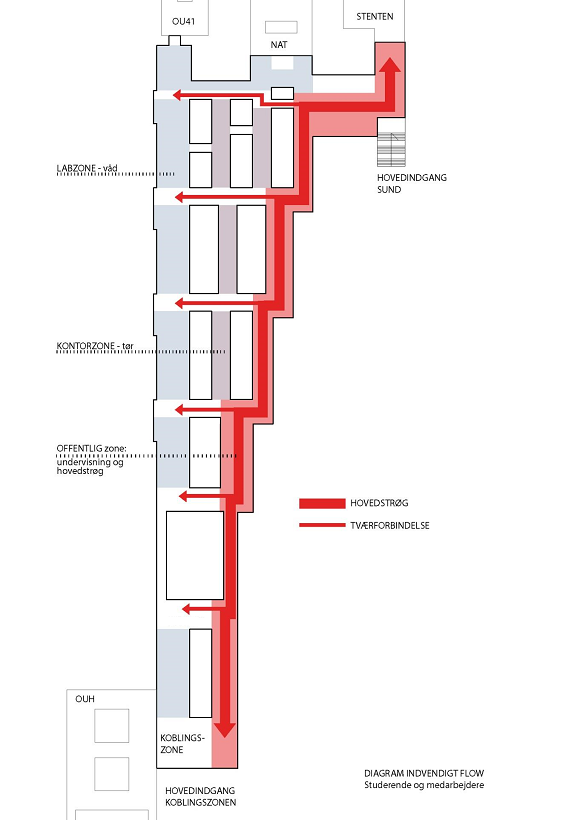
There are no open plan offices in the new HEALTH building.
The offices are primarily designed as enclosed offices in the following sizes:
- 9.3 square meters (2,740 x 3,055)
- 14.2 square meters (2,737 x 4,607)
- 22.6 square meters (4.55 x 4,655)
This will typically provide space for 1, 2, 3, or 4 people, respectively.
See floor plans of the offices in:
The standard furnishing of workplaces in the new HEALTH building focuses on reuse and sustainability.
The starting point is therefore that office furniture is reused in connection with the move. Furniture that is not reused is included in SDU's second-hand market.
New purchases for office furnishings are made collectively from a central level, while financing is decentralized at the institute level.
At the Faculty of Health Sciences, we strive to use office space efficiently to minimize vacancy.
This means that the office workspace should generally be tidy and neutral, so that anyone can use a space that is empty on a given day or week.
This principle supports SDU's work on the Sustainable Development Goals, where buildings are a significant part of our climate impact.
It also supports the paper-minimized office, which is an SDU initiative in connection with our work on the Sustainable Development Goals.
On this basis, there will also be limited space for storage inside the offices.
Instead, it will be possible to equip the original printer rooms with lockable drawers or lockers, so that personal belongings can be stored there.
In a standard layout, offices are designed to accommodate 1-4 workstations and not much else. As a result, there will be limited space for storage inside the offices, including books and personal belongings.
However, the standard layouts can be adjusted locally and supplemented with individual needs. This means that the layout can be adapted decentrally to support the people who use the workstations on a daily basis.
Decisions regarding the specific layout of the offices are made at the individual institutes and in the faculty secretariat, where the allocation of workstations between units and employees will also take place.
It is allowed to have pictures, notice boards, whiteboards, coat racks, and other items on the walls.
However, it is not allowed to hang them directly on the wall. They must be hung on a wall rail (PO rail).
Technical Service will install rails according to the desired and necessary specifications when we move in.
It will be possible to install 1 wall rail per office with corresponding hooks for boards, coat racks, and other items.
Where there is a need to mount a TV screen, Technical Service will assist in mounting it directly on the wall.
Example of hanging with a wall rail:
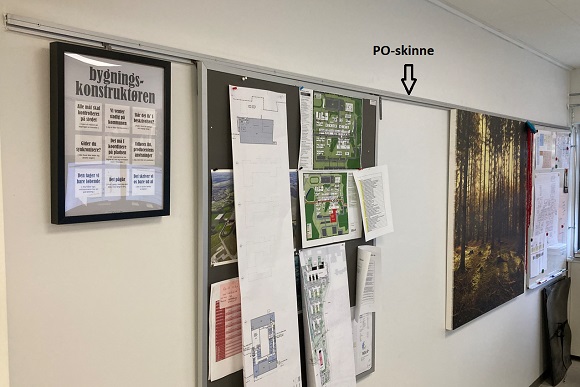
CULTURE:
The Faculty of Health Science's culture is about 'our': Our relationships across units, shared use of facilities and resources, knowledge sharing and collaboration.
The culture is about us collectively having the resources and facilities necessary to deliver research, education, dissemination, and technical-administrative support of the high quality that is the faculty´s goal.
Such a culture is built on trust and recognition of each other's needs and differences.
- You can read more about the faculty's culture and the vision for New HEALTH here. (Please note that the information is in Danish).
With new HEALTH building, we are creating the framework for a relationship-oriented culture with a focus on flexibility and shared use.
This means, among other things:
1. That the building will contain both individual workspaces and shared facilities.- The workspaces are located in offices for typically 1-4 people, surrounded by shared facilities.
- The shared facilities include informal meeting places, meeting rooms, outdoor areas, dining areas, and more.
- While the workspace is for individual work, there are plenty of facilities for other activities.
- When we share facilities and utilize resources collectively, we optimize the way we use the building.
- At the same time, the intention is that shared use of facilities provides more knowledge about each other's work and competencies, which will benefit the community across units.
- In addition, attention to shared use and utilization of resources means that more groups can come together to make purchases and, for example, buy one really good piece of equipment instead of two less good ones.
- If we have the opportunity to arrange our physical presence at work more flexibly, it can improve our work-life balance and thus increase both well-being and efficiency.
- At the same time, flexible presence also enables us to organize our workday in relation to the type of tasks we need to perform. While individual tasks that require immersion and tranquility can be done from home, we can physically show up at work to cultivate communities and solve tasks together.
- Last but not least, flexible presence also supports a better use of space and facilities. This means, for example, that more employees can share an office workspace, so no spaces are left unused during the week.
The faculty management consisting of the dean, secretariat director, and department heads have decided to implement the option of flexible presence for the entire faculty in connection with the move to the new HEALTH building.
Flexible presence will be introduced as an option for all employees at SUND where it makes sense and where the nature of the work allows it, and where it can improve well-being, performance, and job satisfaction.
Flexible presence is being introduced partly to ensure that there will be office space for everyone in the building both at the time of relocation and in relation to growth at the faculty.
In addition, new working methods are an important theme in the vision for New HEALTH in relation to employee well-being. There is a particular focus on meeting the need for individual immersion, work communities, and flexibility.
Central framework - local adaptation
The overall framework for flexible presence is based on common ambitions for the entire faculty (see below), but the specific framework is agreed upon and implemented locally in the departments and in the faculty secretariat.
This means that relevant leaders can make agreements with employees about a combination of working from home and physical presence, which is tailored to local and individual conditions.
Framework and success criteria for flexible presence
- The scheme for flexible presence comes into effect on January 1st, 2023.
- Until then, there will be a learning and pilot period during which the schemes can be agreed locally - for example, where there is a particular interest or immediate need.
- Each institute/unit is allocated an area in the new HEALTH building/OU41, which can be distributed overall. Institutes and units outside the new building will generally retain their current areas.
- Institute/department heads can enter into local agreements on physical presence with employees/groups of employees.
- Planning for physical presence can be done with inspiration from the four models for office culture.
- Office workspaces are set up neutrally, so that others can use the space when it is available.
- The paper-minimized workspace is established.
- All unused daily office space can be used freely, so that vacancy is avoided.
- A decision is made on a common standard for setting up the home office in the implementation.
- Flexible presence and office sharing have been agreed upon for all departments and for all types of employees as of January 1, 2023.
- At least 20% of permanent employees have an agreement on flexible presence at the time of moving in.
- At least 40% of permanent employees will have an agreement on flexible presence as of January 1, 2028.
LABORATORIES:
The new HEALTH building runs in three tracks from SDU in the north to the new OUH in the south.
The western track, which is furthest away from the tram, is the laboratory track.
The three tracks are spread over three floors, with the laboratories primarily located on the first and second floors in the western track.
On the ground floor, you find the biobank, animal stables, storage rooms, changing rooms, and more.

The new HEALTH building is generally laid out in three tracks from SDU in the north to the new OUH in the south. The track furthest to the west is the laboratory track.
The laboratory track is divided into several different laboratory corridors that run along the building. They are delimited by transverse corridors that connect the building's three north-south tracks.
In addition to laboratory facilities, a laboratory corridor also includes workstations for laboratory technicians and researchers directly opposite the laboratories.
Moreover, you will find a kitchenette, meeting rooms, and a toilet at the ends of the laboratory corridor facing the transverse corridors.
Example of a laboratory corridor:
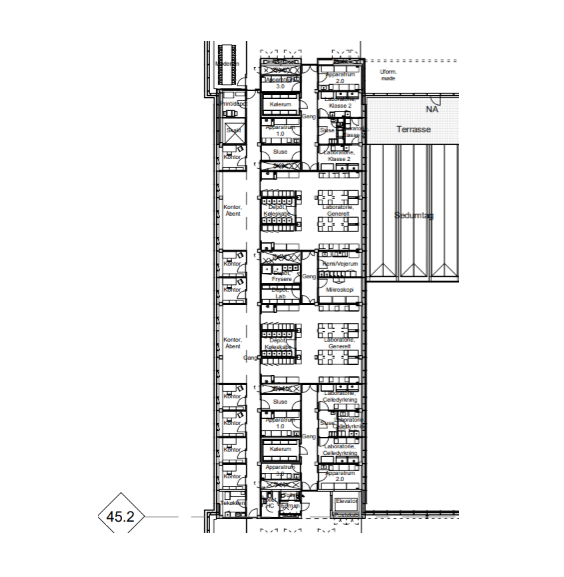
When we talk about common facilities and shared use of facilities, a distinction is made between:
- facilities that are common to the entire Faculty of Health Sciences
- facilities that are common within a laboratory corridor.
The latter facilities are shared among the residents of the area, where the community may include joint finances understood in the sense that, for example, a joint purchase is agreed upon.
Note that the use of the common facilities describes a standard. There may be special circumstances related to specific research procedures.
Common SUND facilities across the entire faculty:
- Dishwashing and autoclave
- Purchase and inventory of standard items
- Biobank BML
- Cell lab class 2
- -80 degree freezers
- Refrigerators and freezers
- Water treatment plant and ice machines
- Workshop function
Common facilities within a laboratory corridor:
- Storage
- Shared room for various equipment
- Extra refrigerators/freezers
- Chemical room, weighing stations, and chemical refrigerators including temperature-stable refrigerators
- Areas for collaborative work and informal ad hoc meetings
MEETINGS:
The new HEALTH building is generally divided into three north-south tracks from SDU in the north to the new OUH in the south. The tracks are spread over three floors.
Laboratories are located in the western track, office areas in the middle, and teaching rooms and study areas are located in the easternmost track.
Throughout the building, the three tracks are connected by transverse corridors.
In the transverse corridors, you will find, among other things, informal meeting areas and access to meeting rooms.
Eksempel på en tværgående korridor:

The meeting facilities in the new HEALTH building are designed to support and accommodate different meeting formats.
Based on this, proposals for the layout of the various meeting rooms have been developed.
You can see the proposals below.
- 5 rooms for seated meetings with a table, 4-5 chairs, and a screen
- 4 rooms for standing meetings with a high table and a screen
Suitable for:
- Seated/standing meetings
- Online meetings
- Conversations and supervision
Examples of layout:
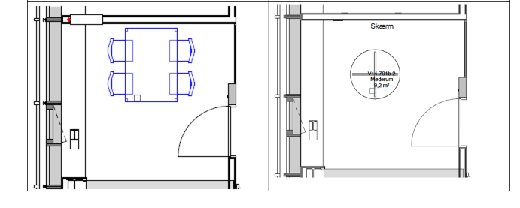
- Height-adjustable meeting table for 7-8 people in 4 of the rooms
- 2 of the rooms are furnished with existing furniture (non-height-adjustable tables)
- Screen and whiteboard in all rooms
- Virtual conference equipment (camera/audio) in one of the roomsPossibility for hybrid meetings in two of the rooms
The rooms are suitable for:
- Online meetings
- Standing/seated meetings
- Planning meetings
- Budget meetings
- Job interviews
- Conversations and supervision
Example of layout:
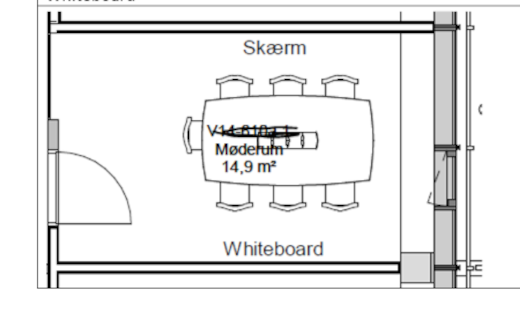
- Space for 14 people
- Table and chairs
- Screen and whiteboard
The rooms are suitable for:
- Seated meetings
- Brainstorming and idea generation
- Project and process development
- Status meetings
- Departmental meetings
Examples of layout:
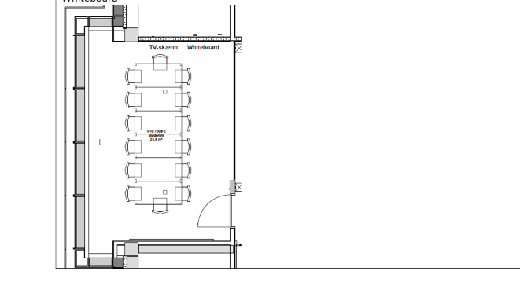
- Space for 14-16 people
- Table and chairs
- Screen and whiteboard
- Desire for hybrid capability in all rooms
2 rooms for seated/standing meetings, which include:
- Space for 14-16 people
- Table(s) and stackable stools
- Screen and whiteboard
The rooms are suitable for:
- Seated/standing meetings
- Brainstorming and idea generation
- Project and process development
- Status meetings
- Departmental meetings
Examples of layout:
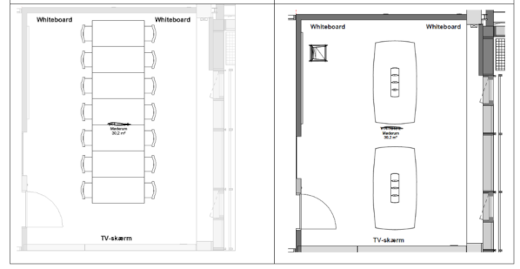
The room includes:
- Space for 20 people
- Table(s) and chairs
- Screen and whiteboard
- Desire for hybrid meeting equipment
The room is suitable for:
- Seated meetings
- Brainstorming and idea generation
- Project and process development
- Status meetings
- Departmental meetings
Example of layout:
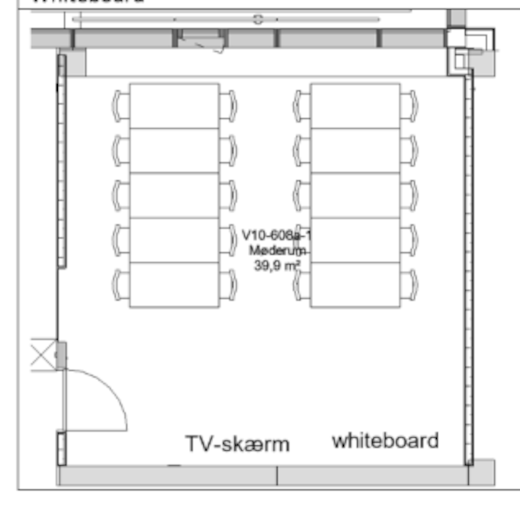
- Space for 22 people in a horseshoe layout
- Space for 24 people in groups
- Table(s) and chairsScreen/projector, audio, and equipment for hybrid meetings:
- 2 x 65" screens + Teams room solution + tracking camera + ceiling microphone + speakers
The rooms are suitable for:
- Seated meetings
- Formal meetings
- Presentations
- Hybrid meetings
Examples of layout:
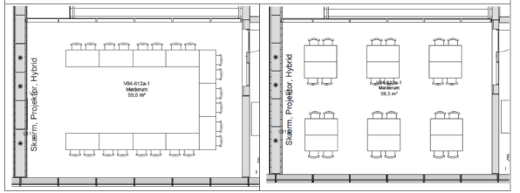
1 room for seated meetings, which includes:
- Space for 25 people in a horseshoe layout
- Table(s) and chairs
- Screen (projector) and whiteboard
1 room for seated meetings, which includes:
- Space for 40 people in two rows
- Table(s) and chairs
- Screen (projector) and whiteboard
The rooms are suitable for:
- Seated/standing meetings
- Brainstorming and idea generation
- Project and process development
- Status meetingsInformational meetings
- Coffee meetings
- Formal meetings
- Departmental meetings
Examples of layout:
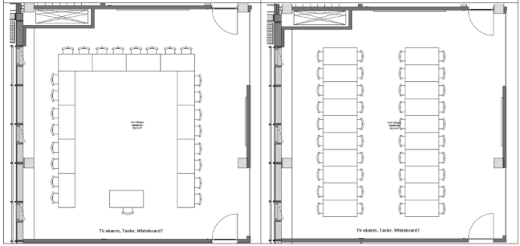
- Space for 18 people
- Table(s) and chairs
- Screen/projector, audio, and equipment for hybrid meetings
The room is suitable for:
- Seated meetings
- Formal meetings
- Presentations
- Hybrid meetings
Example of layout:

- Space for 24 people
- Adjacent lounge area with a screen wall connected to the meeting room
- Table(s) and chairs
Screen/projector, audio, and equipment for hybrid meetings:
- 165" LED screen + 2 x ceiling microphone + tracking camera + speakers
The room is suitable for:
- Seated meetings
- Formal meetings
- Presentations
- Hybrid meetings
The room is intended for meetings with external participants:
- It is the "elegant" meeting room with a central entrance in the Connection Zone.
- The room is somewhat secluded and suitable for representation purposes.
Example of layout:
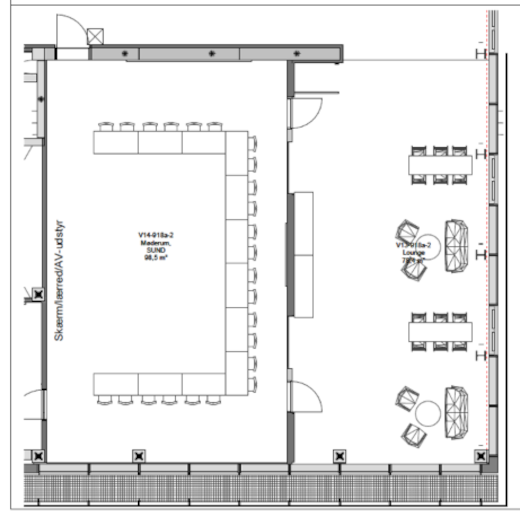
- Space for 84 people in a theater-style seating arrangement
- Space for 48 people in a setup with round tables
- 2 x 165" LED screens
- Audio/speakers
- Microphones
- Online equipment: Tracking camera, instructor microphone, speakers
The room is suitable for:
- Seated meetings
- Status meetings
- Informational meetings
- Presentations
- Departmental meetings
- The room is designed for meetings focusing on:
- Research dissemination
- Knowledge sharing
Example of layout:
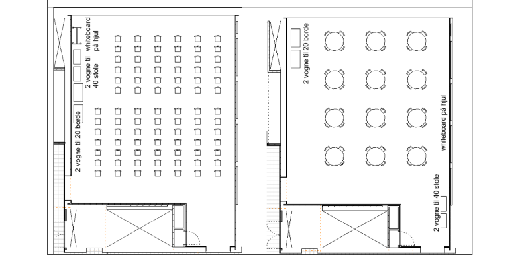
In addition to traditional enclosed meeting rooms, the new HEALTH building contains a range of areas for informal meetings and relaxation.
Proposals have been developed for the layout of these areas, which are located on the first and second floor.
You can see the proposals below.
- They accommodate 2/4/6 people
- They are publicly accessible
- They contain tables and chairs
- They do not have AV equipment
The meeting zones are suitable for:
- Seated/standing meetings
- Casual conversations
- Coffee meetings
- Informal meetings
- Knowledge sharing
- Coworking
Examples of layout:
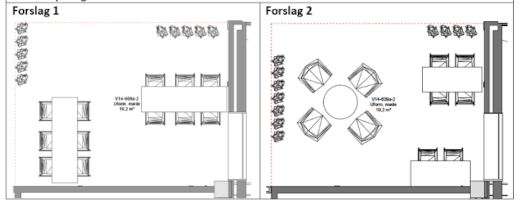
There are 6 meeting zones, each measuring 24 m²:
- They accommodate 2/4/6 people
- They are publicly accessible
- They contain tables and chairs
- They do not have AV equipment
The meeting zones are suitable for:
- Seated/standing meetings
- Casual conversations
- Coffee meetings
- Informal meetings
- Knowledge
- sharingCoworking
Examples of layout:
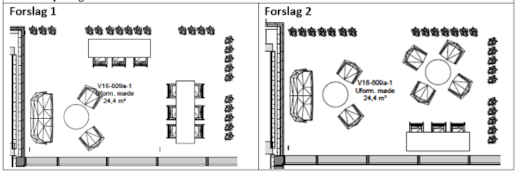
- They contain tables and chairs
- They do not have AV equipment
The areas are suitable for:
- Preparation before presentation at a meeting
Example of layout:
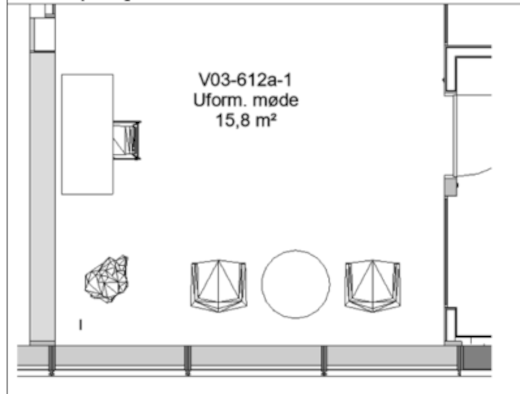
The meeting rooms in the new HEALTH building will be released for booking, as they are completed with furniture and AV equipment.
This will happen during August, and the rooms will gradually become available from week 34. However, please note that all AV equipment may not be fully in place by September 1st.
When a meeting room becomes available for booking, you can find and book it in Outlook.
If you need to reserve meeting rooms on Campusvej before the new meeting rooms in the HEALTH building are released, you are welcome to book the existing meeting rooms on Campus Odense.
NAMING AND SIGNAGE:
The design and placement of maps and signs in the new HEALTH building are based on the signage and wayfinding that exists on the rest of Campus Odense.
With that as a starting point, the following is a proposal for the signage in the building, although there may be changes.
You can see the proposal below. Please note that the information is only available in Danish.
$name
$name
PARKING AND TRANSPORTATION:
500 bicycle parking spaces will be established in connection with the new HEALTH buidling. Of these, approximately 300 will be covered.
The bicycle parking spaces will be established at:
- The main entrance to the new HEALTH building, located where the faculty building connects to the existing SDU.
- The main entrance to Koblingsbygningen, which is the building that connects the faculty building with Nyt OUH.
- The decentralized entrances under the new HEALTH building.
If you arrive at the new HEALTH building by car, you can use one of the 8 SDU parking spaces available around the university.
It is estimated that the established parking facilities will provide enough space, even when the new faculty building is put into use.
If, contrary to expectations, there are too few spaces, an additional 200 to 400 spaces can be quickly established. Two additional parking spaces are ready to be ordered when necessary.
If challenges arise with spaces being used by non-SDU staff/students, it is possible to activate a system with license plate recognition.
View the location of parking spaces around SDU:
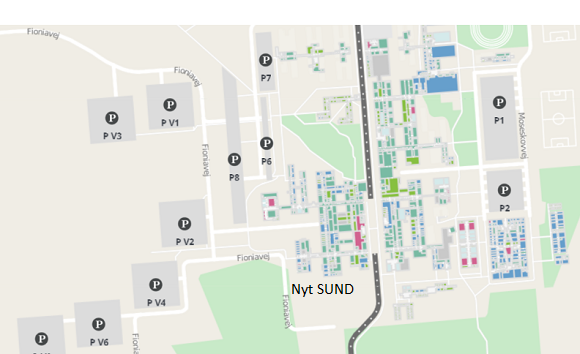
The tram stops at two locations near the new HEALTH building:
- The main entrance to the new HEALTH building, located where the faculty building connects to the existing SDU.
- The main entrance to Koblingsbygningen, which connects the faculty building to Nyt OUH.
SPACE ALLOCATION:
The overall distribution of workplaces in the new HEALTH building has been determined.
It indicates where the individual departments and units will be located and which areas they will each have at their disposal.
The distribution, which has been approved by the faculty management consisting of the dean, department heads, and the faculty's secretariat chief, will serve as a basis for further decentralized planning, where allocation of spaces to departments and employees will take place.
The overall allocation of space in the new HEALTH building has been determined. It indicates how offices and workplaces are distributed among the faculty's different units and will serve as a basis for further decentralized planning.
This means that the institutes and faculty secretariat themselves decide how their areas should be designed, where their different departments should be located, and where each individual employee should have a workspace.
Since this planning takes place locally at the relevant institute or at the faculty secretariat, the process may vary.
Therefore, contact your head of department if you want to know more about the decentralized planning and allocation of spaces.
In addition to workspaces for the faculty's institutes and faculty secretariat, space has also been allocated in the new HEALTH building for:
- Meeting rooms
- Meeting areas/common areas for the faculty
- Dining area
- Teaching
- Study zones/common areas for SDU
- Student organizations
- Biobank
- Technical and operational support
- Other facilities such as kitchenettes, printer rooms, etc.)
See the overall allocation of spaces in the new HEALTH building.
MAIL, PACKAGES AND GOODS:
When we move to the new HEALTH building, all goods, letters, and packages must be addressed to:
Campusvej 55
5230 Odense M
They will be handled by Technical Service, Logistics, who will ensure that they are forwarded.
For The Faculty of Health Sciences, this means that they will be delivered to one of four central reception rooms on the ground floor of the new faculty building.
All letters, goods and packages are delivered to one of four central reception rooms located on the ground floor of the new HEALTH building.
You will need to collect your mail from the reception room assigned to you.
As the system for digital notification of mail is not fully developed yet, you will need to check the reception room yourself as a default.
Reception Rooms:
The four central receiving rooms are located in buildings OU 41 and the new HEALTH building, in sections 45.2, 45.4, and 45.6.
All rooms are equipped with Mail/pigeonhole and shelves.
There will be electronic access control at the entrance doors to monitor who accesses the rooms.
Here you can see an overview of the reception rooms.
In addition to the four central rooms, the Biomedical Laboratory also has its own receiving room in the new HEALTH building.
WASTE SORTING:
The Faculty of Science has conducted a pilot project on waste sorting in office corridors.
The solutions tested in the pilot project are now being expanded to the rest of the campus, including the new HEALTH building, as part of SDU's climate plan.
This means that there will be no waste bins in the offices in the new building.
As on the rest of SDU, they will be replaced by central waste stations in corridors and common areas, where sorting can be done in several fractions.
In addition to waste stations in common areas, there will also be waste stations in connection with laboratories in the new HEALTH building, for example.
Below you will find information on different types of waste stations in the new HEALTH building - and where they are located. Please note that the information is only available in Danish.
TYPES OF WASTE STATIONS
Affaldsstationer i laboratorier til:
- Risikoaffald (spande med gule poser)
- Restaffald
- Hård plast
- Blød plast
- PE-plast
- Pap/papir
Affaldsspande på trolley eller bordsortering i apparatrum til:
- Risikoaffald
- Restaffald
Affaldsrum på laboratoriegange til:
- Risikoaffald (spande med gule poser)
- Hård plast
- Blød plast
- Restaffald
- PE-plast
- Pap/papir
- Glas/metal?
Siden Nyt SUND blev designet, er det sket tilpasninger på SDU, som har reduceret behovet for kopirum. Det betyder, at 4 kopi/depotrum i Nyt SUND på henholdsvis 1. og 2. etage bliver omdannet til affaldsrum.
Rummene er placeret tæt på laboratorierne i den vestlige side af bygningen, hvor de skal understøtte affaldssortering fra laboratoriegangene.
Fælles affaldsstationer på gangarealer til:
- Restaffald
- Mad- og drikkekartoner + plastik
- Organisk affald
- Metal/Glas
- Papir/pap
Affaldsspande i tekøkkener til:
- Organisk affald
- Restaffald
Affaldsrum på terræn til:
- Pap/papir
- Organisk affald
- Hård plast
- Blød plast
- PE-Plast
- Restaffald
- Polystyren
- Glas, metal, jern
- Elektronik affald
Rengøringsfirmaet ISS sørger for, at al affald fra 1. og 2. sal kommer ned i de store affaldsrum på terræn, hvorfra det bliver afhentet af Marius Pedersen.
PLACEMENT OF WASTE STATIONS
Placering af affaldsstationer på første sal:
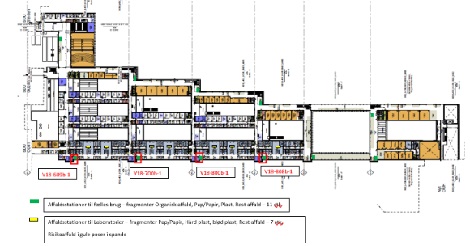
Placering af affaldsstationer på anden sal:
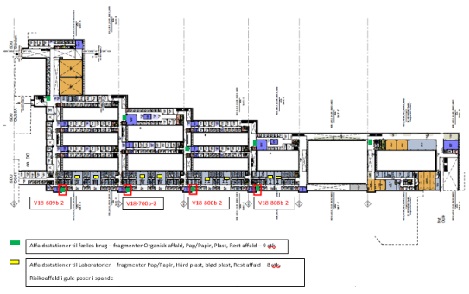
Since the new HEALTH building was designed, adaptations have taken place at SDU, which have reduced the need for print rooms.
This means that 4 print rooms on the 1st and 2nd floors respectively will be converted into waste rooms.
The rooms are located close to the laboratories on the western side of the building, where they must support waste sorting from the laboratory corridors.
In the laboratory corridors, there will also be waste stations in the laboratories and in the apparatus rooms.
In addition to waste stations in connection with the laboratories, there will also be shared waste stations by the office corridors.
Below you will find information about different types of waste collection in the new HEALTH building - and where these are located. Please note that the information is only available in Danish.
TYPES OF WASTE STATIONS
Affaldsstationer i laboratorier til:
- Risikoaffald (spande med gule poser)
- Restaffald
- Hård plast
- Blød plast
- PE-plast
- Pap/papir
Affaldsspande på trolley eller bordsortering i apparatrum til:
- Risikoaffald
- Restaffald
Affaldsrum på laboratoriegange til:
- Risikoaffald (spande med gule poser)
- Hård plast
- Blød plast
- Restaffald
- PE-plast
- Pap/papir
- Glas/metal?
Siden Nyt SUND blev designet, er det sket tilpasninger på SDU, som har reduceret behovet for kopirum. Det betyder, at 4 kopi/depotrum i Nyt SUND på henholdsvis 1. og 2. etage bliver omdannet til affaldsrum.
Rummene er placeret tæt på laboratorierne i den vestlige side af bygningen, hvor de skal understøtte affaldssortering fra laboratoriegangene.
Fælles affaldsstationer på gangarealer til:
- Restaffald
- Mad- og drikkekartoner + plastik
- Organisk affald
- Metal/Glas
- Papir/pap
Affaldsspande i tekøkkener til:
- Organisk affald
- Restaffald
Affaldsrum på terræn til:
- Pap/papir
- Organisk affald
- Hård plast
- Blød plast
- PE-Plast
- Restaffald
- Polystyren
- Glas, metal, jern
- Elektronik affald
Rengøringsfirmaet ISS sørger for, at al affald fra 1. og 2. sal kommer ned i de store affaldsrum på terræn, hvorfra det bliver afhentet af Marius Pedersen.
PLACEMENT OF WASTE STATIONS
Placering af affaldsstationer på første sal:

Placering af affaldsstationer på anden sal:

TOILETS AND SHOWER FACILITIES:
In the new HEALTH building, there is access to toilets on the ground floor as well as on the first and second floor.
On all three floors, the toilets are distributed throughout the entire building from SDU in the north to new OUH in the south.
See the location of toilets on the floor plan here.
- Toilets are included in the category Birum, which is marked with a clear green color.
Roughly in the middle of the New SUND Building, you'll find changing facilities on the ground floor.
The facilities consist of:
- A changing room for gentlemen with 3 showers in building section 45.3 (on the right in the illustration below).
- A changing room for ladies with 3 showers in building section 45.3 (on the right in the illustration below).
- A accessible toilet with a shower in building section 45.2 (on the left in the illustration below).
Location of handicap toilets with shower facilities on the ground floor:
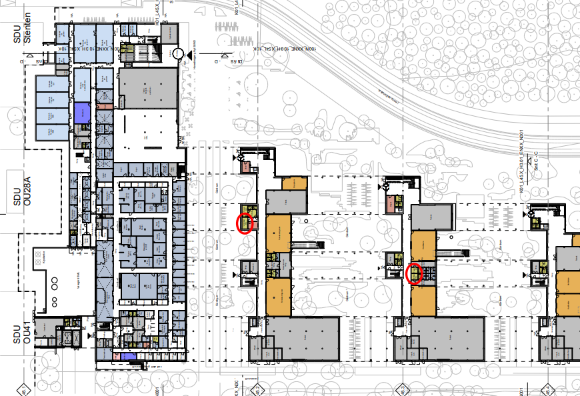
TEACHING AND STUDY ENVIRONMENT:
The new HEALTH building is generally laid out in three north-south tracks from SDU in the north to Nyt OUH in the south. The tracks are distributed over three floors.
In the track furthest east, on the first floor, there is a corridor with:
- Classrooms
- Group rooms
- Practice laboratories
- Auditoriums
- Study areas
- Meeting areas
From the corridor, there is also access to teaching facilities on the ground floor.
The classrooms and study areas are thus centrally and coherently located, creating a vibrant study environment.
Furthermore, the teaching facilities are located in such a way that the students will have a natural connection to both the university and the university hospital.
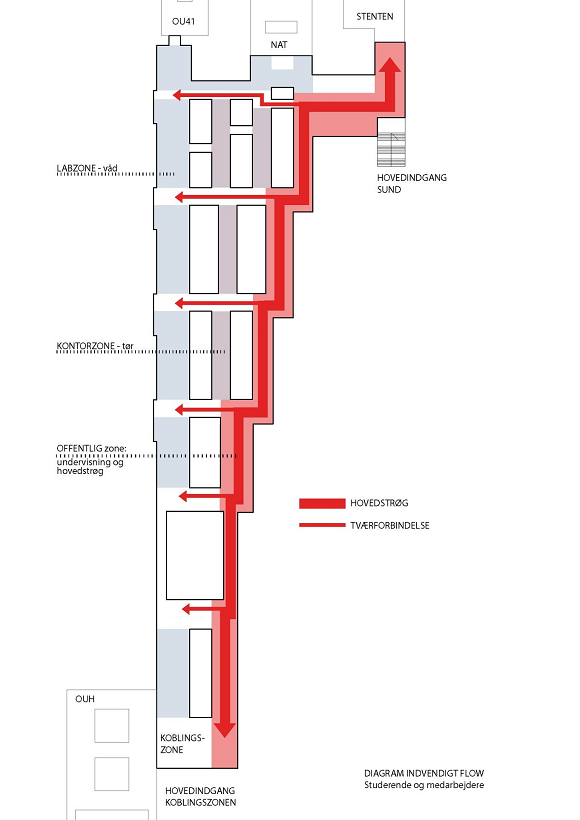
See the location of the teaching facilities on the floor plans here.
There are a total of 55 classrooms in the new HEALTH building.
Out of these, 42 are regular classrooms that are shared and can be booked and used by everyone across SDU.
Additionally, there are 13 special classrooms reserved for The Faculty of Health Sciences and can only be booked and used by relevant users.
The classrooms are evenly distributed throughout the building and are designed to accommodate various teaching methods.
The teaching facilities in the new HEALTH building are designed to support and accommodate different teaching methods.
Based on this, a proposal for the layout of all 55 classrooms in the building has been developed.
Out of these, 42 are general classrooms that are shared and can be booked and used by everyone across SDU.
Additionally, there are 13 special classrooms reserved for SUND and can only be booked and used by relevant users.
Shared SDU classrooms:
- U240, U241, U250
- U320, U321, U322, U323, U324
- U360, U361, U362, U363
- U460, U461
Layout:
- 6 team rooms with group seating, accommodating 42 students + 1 instructor in each room.
- 8 team rooms with row seating, accommodating 40 students + 1 instructor in each room.
The two layouts were chosen based on didactic considerations and capacity requirements.
In addition, the expected use of each room has influenced the seating arrangement.
For example:
- Row seating in rooms with streaming equipment.
- Row seating in the room closest to "iLab South" to allow for small presentations before and/or during skills training.
- Group seating in 6 out of 14 team rooms to promote and support active teaching and learning.
Equipment:
- Chalkboard.
- In the 11 rooms without streaming equipment: Clip microphones and speakers.
- In the 3 rooms with streaming equipment: Tracking camera, ceiling microphones (used by both students and teachers), and speakers.
Examples of layouts:
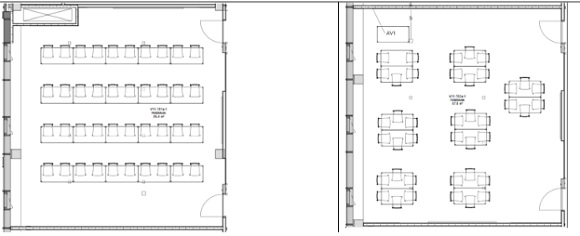
- Both rooms have group seating, accommodating 36 students + 1 teacher in each room.
- The rooms are equipped with fixed cabinets containing equipment specifically designed for skills training in the Clinical Skills Laboratory.
- This setup provides good conditions for group work during skills training.
- The rooms can also be used for other teaching, where they are particularly suitable for teaching that involves group work.
Equipment:
- 1 projector, screen (300x169).
- Audio/speakers.
- Chalkboard.
- Cabinets.
Examples of layouts:
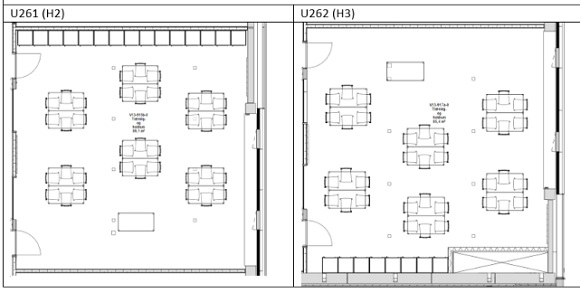
- Both rooms have a row arrangement, which accommodates 56 students in each room.
- The row arrangement was chosen based on didactic considerations and capacity needs.
- The room is well-suited for both lecture-style teaching and interactive presentation sessions.
- The even number of rows in the room promotes the possibility of group work, as students on every other row can easily turn around.
Equipment:
- Streaming equipment: Tracking camera, 2 x ceiling microphone, speakers.
- 1 projector, screen (300x169).
- Audio/speakers.
- Chalkboard.
Example of layout:
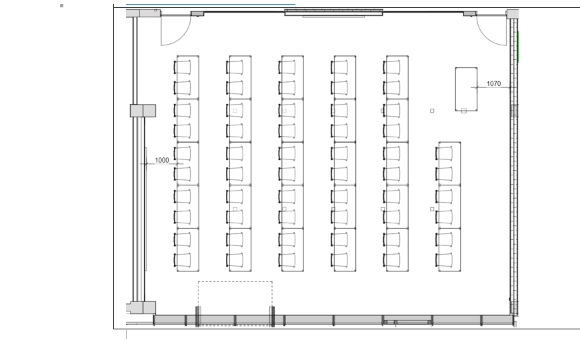
- Both rooms are furnished with a mix of row and group arrangements, accommodating 64 students in each room.
- The mixed layout is due, among other things, to the fixed column located in the center of each room, while also being chosen based on didactic considerations and capacity needs.
- The rooms can be used for lectures but are also ideal for group work, as the front rows can turn around and collaborate with the next row, while the other students are already placed in groups.
Equipment:
- 2 x projector, 2 x motorized screen (342x169).
- Chalkboard.
- In U221, the room without streaming equipment: Clip microphones and speakers.
- In U220, the room with streaming equipment: Tracking camera, ceiling microphones (used by both students and teachers) and speakers.
Examples of layout:
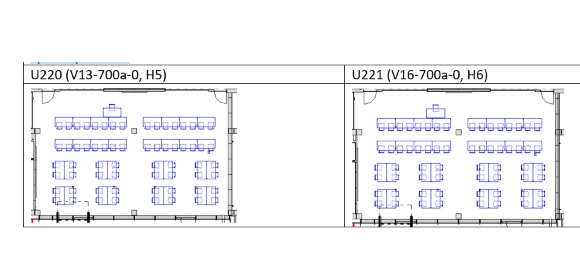
- The room has a flat floor and is furnished with round tables and a podium for the instructor.
- There is room for 160 students in the room.
- The round tables invite group work and discussions, facilitated by the instructor.
- The layout particularly encourages activity and feedback supported by the latest technology.
Equipment:
- Streaming equipment: Tracking camera, clip microphones for instructors, speakers.
- 2 x 165” LED screens.
- Audio/speakers.
- Wireless microphones for attendees (catchboxes, handheld).
- 9 mobile stations consisting of a wheeled stand with a screen that participants can connect to via HDMI. Ideal for group work, poster presentations, or other project work.
- 3 whiteboards on the wall under the screen.
- A number of mobile whiteboards.
Example of layout:
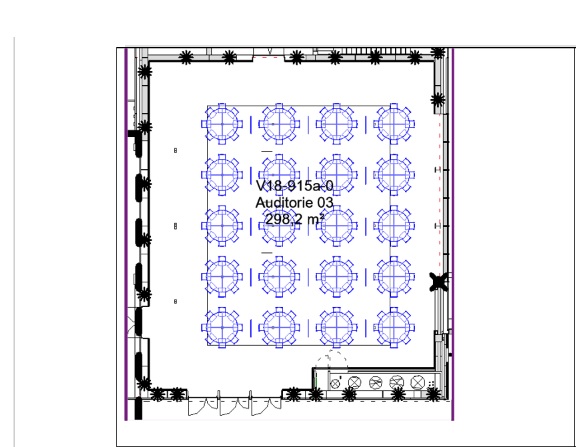
- The auditorium is arranged as a classic lecture hall with one row of seats on each level.
- There is room for 228 people + 2 wheelchair spaces.
- The room is expected to be primarily used for lectures.
- However, with two screens in the auditorium, there are also ample opportunities to incorporate digital elements that engage the students.
Equipment:
- Streaming equipment: Tracking camera, clip microphones for instructors, speakers.
- 2 x 165” LED screens.
- Chalkboards under the LED screens.
- Audio/speakers.
- Wireless microphones for attendees (catchboxes, handheld).
Example of layout:
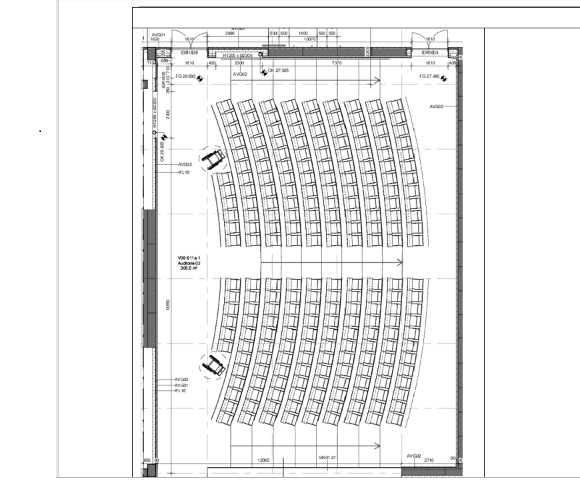
- The room is designed with two rows of chairs on each level, so that the front row on each level can turn around and do group work with those sitting on the back row.
- There is space for 189 people + 2 handicap seats.
- The room is particularly suitable for teaching methods such as "Team Based Learning" (TBL teaching) and other activities where students need to interact orally with each other.
Equipment:
- Streaming equipment: tracking camera, clip-on microphones for teachers, speakers.
- 2 x 165” LED screens.
- Chalkboards under the LED screens.
- Audio/speakers.
- Wireless microphones for audience members (catchboxes, handheld).
Example of layout:
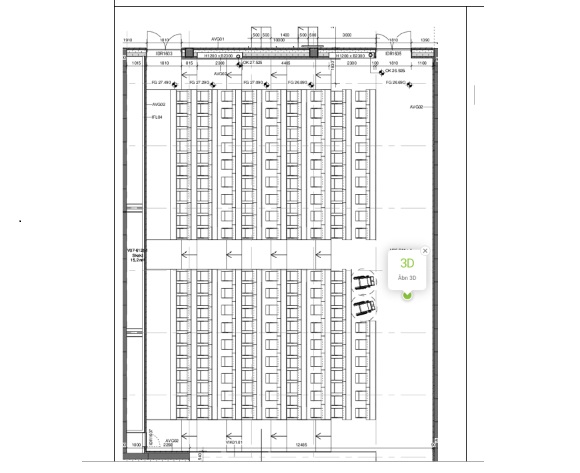
- U310, U311, U312
- U330, U331, U332, U333, U334, U335
Layout:
- The 9 group rooms are furnished with different setups, each accommodating up to 10 people.
- Through the installed screen, collaborative work on common projects and/or online/hybrid study group meetings can be conducted.
- The group rooms can also be used for teaching smaller groups.
Equipment:
- One 65” screen per room.
- Whiteboard.
Examples of layout:
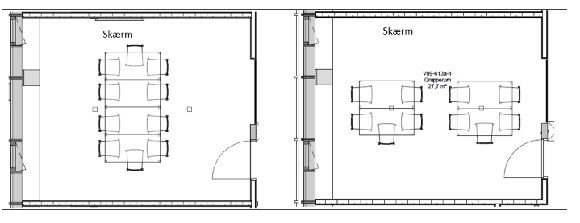
- The 2 group rooms are furnished with round and square group tables and can each accommodate 28 students.
- The group rooms can accommodate multiple smaller groups working together or teaching that primarily involves group work.
Equipment:
- 6 x mobile whiteboard.
Examples of layout:
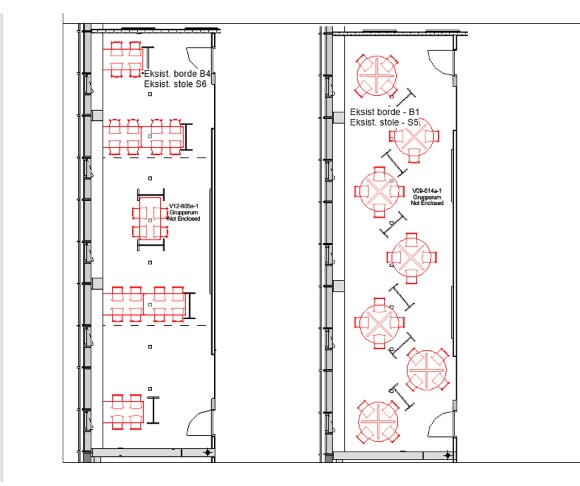
- U340, U341, U342, U343, U344, U345
Layout:
- The rooms are intended for physiology exercises.
- Outside the period with physiology exercises, the rooms can be used as group rooms.
- When the rooms function as group rooms, there is room for 12 students.
Equipment:
- Whiteboard.
- Curtains.
- Exercise mats.
- Fixed laboratory tables.
- Glove holders.
- Foldable table frame for when the room needs to change function between group room and exercise lab.
Examples of layout:
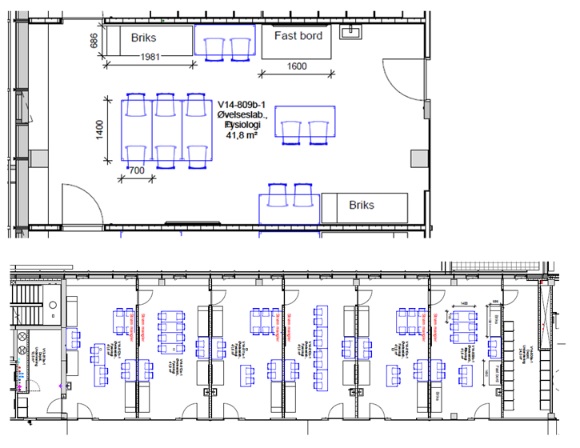
- The 2 group rooms are furnished with round and square group tables, respectively, and can each accommodate 28 students.
- The group rooms can accommodate multiple smaller groups working together or teaching where group work is primarily carried out.
Equipment:
- 5 x mobile whiteboard.
Examples of layout:
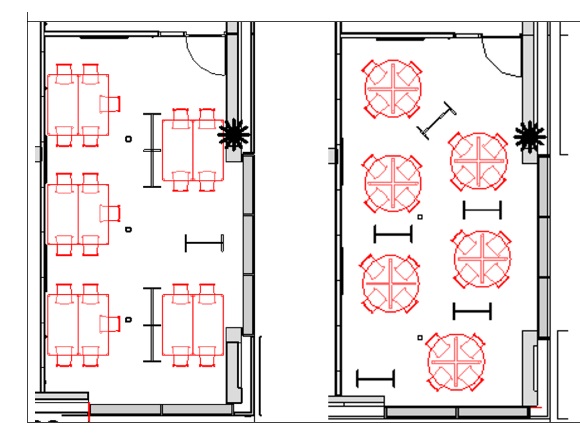
HEALTH-specific classrooms:
- The rooms are used for specific exercise sessions in the Medicine and Clinical Biomechanics programs.
- Outside of teaching periods, the rooms are used for research.
- The rooms are named SUND-large lab and SUND-small lab.
Layout:
- The two laboratories are equipped with fixed lab benches, consoles, and sinks.
Equiptment:
- Refrigerators.
- Freezers.
- Centrifuges.
- Flow hoods and incubators for cell culture.
- Whiteboard.
- Coat rack available outside the rooms.
Example of layout:
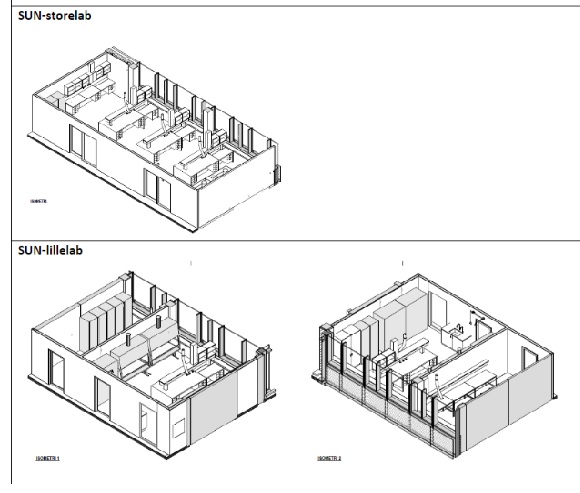
- U371, U373, U375, U377, U372, U374
Usage:
- The rooms are used for group instruction in anatomy in the Medicine and Clinical Biomechanics programs.
- The occupancy is so high that the rooms are currently not available for other purposes.
- Access to the rooms is limited to relevant users.
Layout:
- Each room contains 9 tables.
- The layout will be periodically adjusted by the users based on their needs. Examples of layout solutions can be seen in the drawings below.
- The rooms are equipped with suction and sinks to facilitate teaching with "wet preparations" (anatomy).
Equipment:
- Interactive boards including Mac mini.
- Whiteboard located on the side facing the windows.
Example of layout:
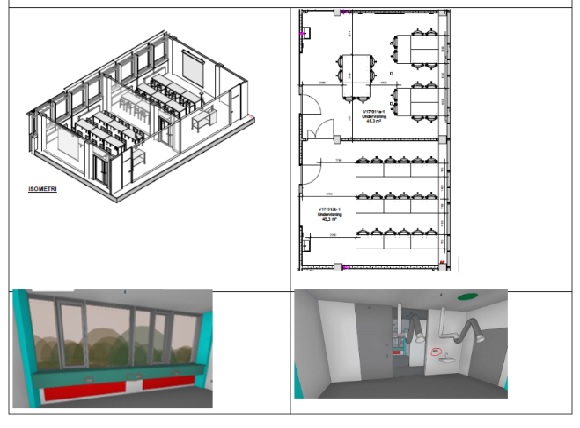
- The room is arranged in rows, providing space for 44 students.
- The row setup is chosen based on didactic considerations and capacity needs.
Equipment:
- iMac computer.
- 1 projector, projection screen (300x169).
- Audio/speakers.
- 48 x Microscopes.
- Whiteboard.
- Cabinets.
Example of layout:
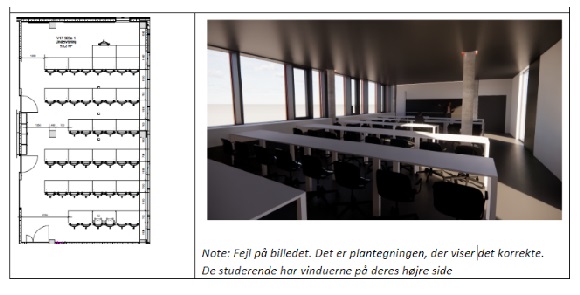
- The purpose of iLab South, as the workshop room is called, is to teach practical skill training in the health sciences programs.
- The room is primarily targeted towards the Medicine and Clinical Biomechanics programs. However, it can also be used by other programs that require workbenches for practical skill training.
- Access to the room is limited to relevant users.
Layout:
- The room is designed with a focus on technology that supports practical skill training instruction.
- The pedagogical principles for modern practical skill training instruction are described in four teaching scenarios, with teaching scenario 1 expected to be the primary teaching method in iLab South.
- However, all 4 teaching scenarios are made possible:
- Teaching with PowerPoint and video
- Group work with video
- Ongoing supervision with video
- Independent practice with video
The setup also provides students with a conducive environment to practice practical skills, with the ability to review instructional videos on the screens in the room.
Equipment:
- 6 TV screens including Apple TV.
- iMac computer.
- Creston control panel.
- Instructor iPad.
- Audio/speakers.
- Microphones/headsets.
- 22 workbenches.
- 25 chairs + chair trolley.
- Instructor's desk.
- 5 cabinets.
- Keybox (iPad, keys for cabinets, microphones, etc.).
- Training mats + hooks for hanging.
- Hand sanitizer dispensers.
Example of layout:

- The room is dedicated to dissection teaching in the Medicine and Clinical Biomechanics programs.
- It is also used for postgraduate/A-courses.
- Access to the room is limited to relevant users.
Layout:
- The room is equipped with 8 fixed dissection tables, a number of cabinets, and sinks.
Equipment:
- 4 screens
Example of layout:
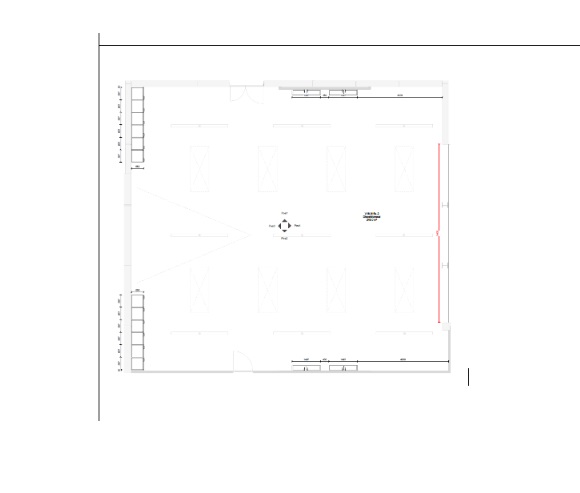
- The study halls replace what was previously referred to as "Tørsalen."
- The study halls are intended for students to engage in group work or individually immerse themselves in their studies.
- The study halls are divided into an open anatomy room and a closed anatomy room, collectively referred to as the Museum.
- While all students can use the open anatomy room, only students from the Medicine and Clinical Biomechanics programs have access to the closed anatomy room. Otherwise, access is granted by special arrangement.
Layout and equipment:
- Desks with accompanying chairs.
- Glass cabinets with anatomical specimens.
Examples of layout:
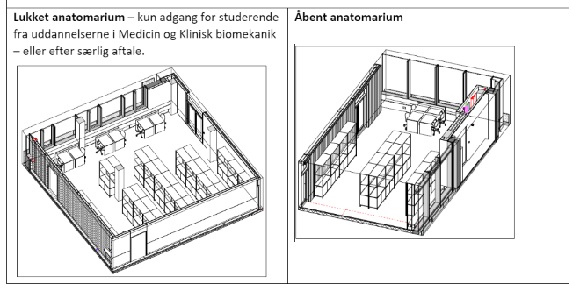
The majority of the teaching that currently takes place in Winsløvparken (WP) is expected to take place in the new HEALTH building from September 1, 2023.
However, certain activities depend on the new OUH also being put into use. This includes activities related to the Laboratory for Clinical Skills.
Therefore, there is currently a focus on how to piece together the puzzle based on the many considerations that need to be taken into account, such as schedule planning and use of locations.
Read more about what will happen with the teaching during the interim period. Please note that the information is only available in Danish.
A number of measures have been initiated to ensure good conditions for teaching during the period when The Faculty of Health Sciences has moved to Campus Odense while OUH is still on the existing site.
On this webpage, you can read more about the measures and find answers on how teaching will be conducted during the interim period. Please note that the information is only available in Danish.
The teaching rooms in the new HEALTH building are now available for booking.
They can be booked in Time-Edit - with reservations from September 1, 2023, and onwards.
In the New SUND building, various rooms have been allocated to the faculty's student organizations.
- 1 room on the first floor in New SUND for meeting activities for SUND's student organizations.
- 1 room on the first floor in New SUND for social gatherings for SUND's students
- 3 rooms in the basement for SUND's student organizations.
- Space in dry biobank for storage of materials for SUND's student organizations.
The rooms on the first floor in New SUND are located in building 45.1. It is the building that connects to the existing SDU
Student organizations' rooms on the first floor:
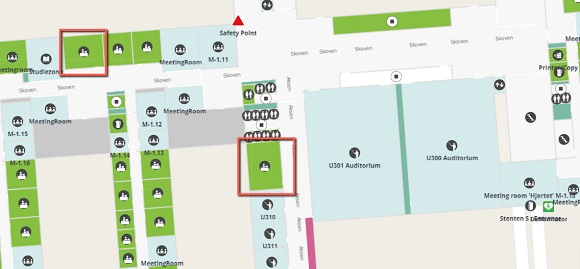
See the distribution of areas on the entire first floor of the new HEALTH building here.
WINDOWS AND VENTILATION:
- Have windows to the outside
- Most windows can be opened as needed
- Have mechanical ventilation
Meeting rooms/group rooms:
- Generally do not have windows
- Have mechanical ventilation
Teaching rooms:
- Have windows to the outside
- Windows can be opened as needed
- Have mechanical ventilation
Laboratories:
- Often have windows
- Windows cannot be opened: This is for both personal safety and safety of the work being performed, as the pressure in the room must be controlled.
- Have mechanical ventilation.
- Kontorer ventileres mekanisk.
- Det sker konstant i perioden fra 1 time før normalt arbejdstid og til kl. ca. 22.00.
- Det betyder der altid vil være frisk luft, når man møder ind.
- Oplukkelige vinduer, som kan benyttes uafhængigt af den mekaniske ventilation.
Møderum/grupperum:
- Møderum, grupperum og lignende ventileres mekanisk.
- Det sker ved, at der konstant måles på luftkvaliteten og luftskiftet reguleres automatisk.
- Ventilationen kan stilles til at køre konstant, hvis der er behov for det.
- Der er generelt ikke vinduer i møderum/grupperum.
Undervisningsrum:
- Undervisningsrum ventileres mekanisk.
- Ventilationen starter før planlagt brug af rummet, så der ren luft når undervisningen starter.
- Ventilationen vil desuden køre automatisk, når der er personer til stede i rummet.
- Oplukkelige vinduer, som kan benyttes uafhængigt af den mekaniske ventilation.
Laboratorier:
- Laboratorier har mekanisk ventilation og køl.
- Vinduer i laboratorier kan ikke åbnes, da der skal være styr på trykket i rummet.
Looking for answers?
If you have a questions about New HEALTH that you cannot find an answer to, you are very welcome to contact us.
